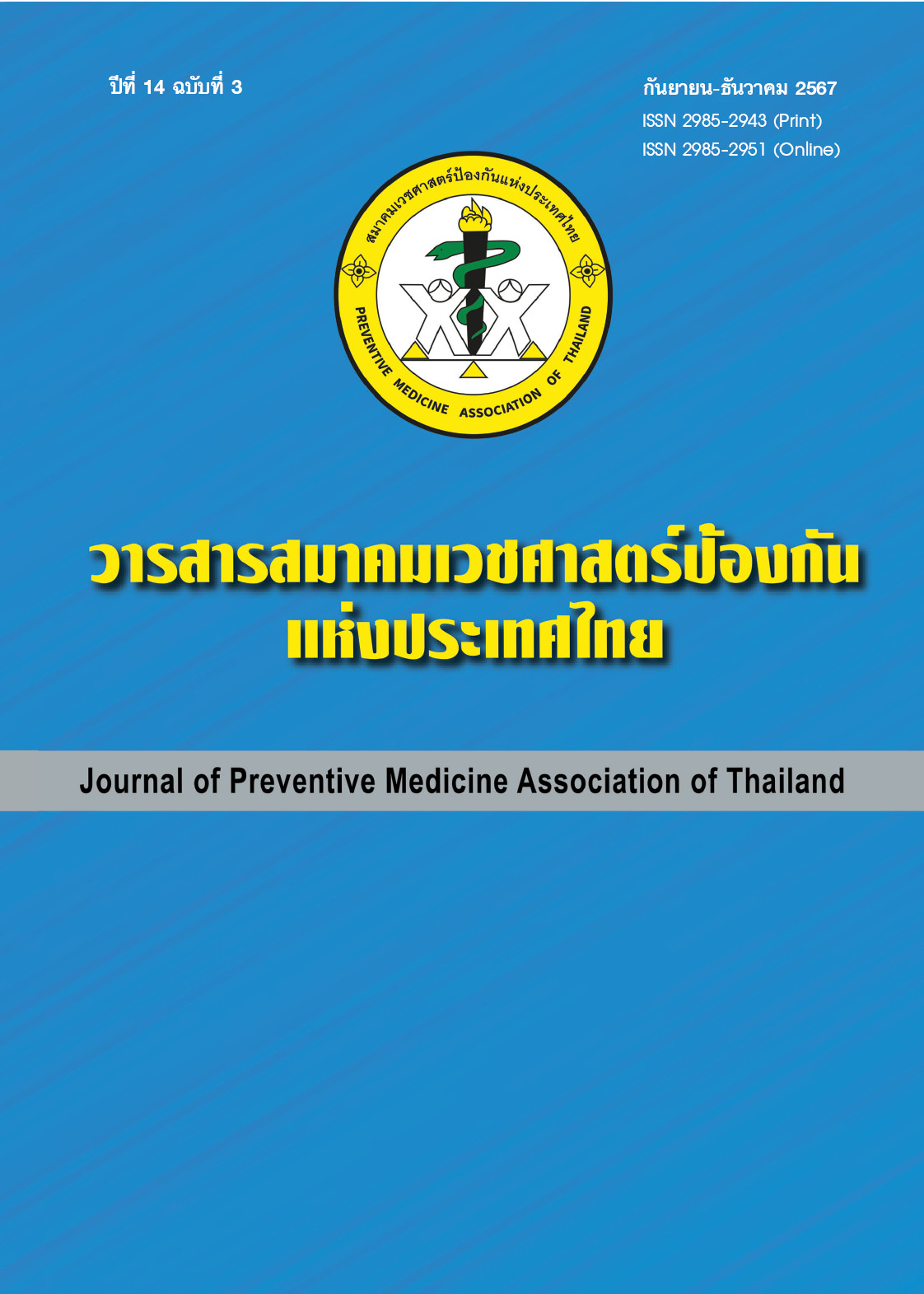Factors Influencing the Timeliness of Treatment for Acute Stroke Patients at Banmi Hospital, Lopburi
Keywords:
acute stroke, timely treatment, stroke severity scaleAbstract
Objective: To examine factors influencing the timeliness of treatment for acute stroke patients at Banmi Hospital, Lopburi. Methods: This is a retrospective analytic study aimed at investigating the factors influencing timely treatment of acute stroke patients at Banmi Hospital, Lopburi Province. The research population consisted of patients presenting with acute stroke symptoms who were treated in the emergency department and outpatient clinic, and who were diagnosed with acute stroke between October 1, 2018, and September 30, 2023. The sample comprised 212 patients, divided into a study group of 106 patients and a control group of 106 patients. Results: The multivariate analysis revealed that the factors influencing the prediction of timely treatment within three hours for acute stroke patients included: having a history of stroke (ORadj = 0.02, 95% CI: 0.00-0.25), having a history of heart disease (ORadj = 20.18, 95% CI: 2.46-165.61), and having severe symptoms (GCS ≤ 8) (ORadj = 5.54, 95% CI: 1.17-26.14). Conclusion: Timely treatment of stroke significantly impacts the quality of life for patients. Therefore, raising public awareness to ensure timely access to treatment, as well as educating the community about the symptoms and warning signs of acute stroke, is crucial. This is essential to prevent mortality or disability among the population.
References
World Stroke Organization. Global stroke fact sheet 2022 [Internet]. 2023 [cited 2023 Aug 12]. Available from: https://www.world-stroke.org/assets/downloads/WSO_Global_Stroke_Fact_Sheet.pdf
World Health Organization. World health statistics 2024: monitoring health for the Sustainable Development Goals (SDGs). Geneva: World Health Organization; 2024.
สถาบันการแพทย์ฉุกเฉินแห่งชาติ. รายงานการศึกษาสถานการณ์บริการการแพทย์ฉุกเฉินและการพัฒนาคุณภาพปฏิบัติการฉุกเฉินผู้ป่วยโรคหลอดเลือดสมอง. นนทบุรี: สถาบันการแพทย์ฉุกเฉินแห่งชาติ; 2565.
ระบบคลังข้อมูลด้านการแพทย์และสุขภาพ กระทรวงสาธารณสุข. การป่วยด้วยโรคไม่ติดต่อที่สำคัญ 2566. [อินเทอร์เน็ต]. 2566 [เข้าถึงเมื่อ 10 ก.ค.2567]. เข้าถึงได้จาก: https://qrcd.org/7PlZ
สมศักดิ์ เทียมเก่า. อุบัติการณ์โรคหลอดเลือดสมองในประเทศไทย. วารสารประสาทวิทยาแห่งประเทศไทย 2566;39(2):39-46.
กรมการแพทย์. เลือดออกในสมองจากหลอดเลือดสมองแตกอันตรายถึงตาย [อินเทอร์เน็ต]. 2567 [เข้าถึงเมื่อ 22 ก.ค.2567]. เข้าถึงได้จาก: https://www.dms.go.th/Content/Select_Landding_page?contentId=49899
ระบบคลังข้อมูลด้านการแพทย์และสุขภาพ กระทรวงสาธารณสุข. อัตราอุบัติใหม่ของโรคหลอดเลือดสมอง [อินเทอร์เน็ต]. 2566 [เข้าถึงเมื่อ 10 ก.ค.2567]. เข้าถึงได้จาก: https://qrcd.org/7Pld
สถาบันการแพทย์ฉุกเฉินแห่งชาติ. โรคหลอดเลือดสมอง (Stroke): ความรู้สำหรับผู้ปฏิบัติการด้านการแพทย์ฉุกเฉิน. นนทบุรี: สถาบันการแพทย์ฉุกเฉินแห่งชาติ; 2564.
อารยา พิทักษ์โรจนานนท์. ปัจจัยที่มีความสัมพันธ์ต่อระยะเวลาการมารับการรักษาของผู้ป่วยโรคหลอดเลือดสมองเฉียบพลันในโรงพยาบาลสมเด็จพระยุพราชจอมบึง จังหวัดราชบุรี. วารสารวิชาการสำนักงานสาธารณสุขจังหวัดมหาสารคาม 2567;8(16):185-97.
Lacy CR, Suh DC, Bueno M, Kostis JB. Delay in presentation and evaluation for acute stroke: stroke time registry for outcomes knowledge and epidemiology (S.T.R.O.K.E.). Stroke 2001;32(1):63-9.
Wannarong T, Chotik-Anuchit S, Nilanont Y. Factors associated with hospital arrival time in acute stroke. J Med Assoc Thai 2019;102(5):547-53.
Kim YS, Park SS, Bae HJ, Cho AH, Cho YJ, Han MK, et al. Stroke awareness decreases prehospital delay after acute ischemic stroke in Korea. BMC Neurol 2011;11:2.
Derex L, Adeleine P, Nighoghossian N, Honnorat J, Trouillas P. Factors influencing early admission in a French stroke unit. Stroke 2002;33(1):153-9.
พัชราภรณ์ ปินตา. ปัจจัยทำนายการมารักษาทันเวลาของผู้ป่วยโรคหลอดเลือดสมองระยะเฉียบพลัน. วารสารระบบบริการปฐมภูมิและเวชศาสตร์ครอบครัว 2564;4(3):46-58.
Downloads
Published
How to Cite
Issue
Section
License
Copyright (c) 2024 สมาคมเวชศาสตร์ป้องกันแห่งประเทศไทย

This work is licensed under a Creative Commons Attribution-NonCommercial-NoDerivatives 4.0 International License.
บทความที่ลงพิมพ์ในวารสารเวชศาสตร์ป้องกันแห่งประเทศไทย ถือเป็นผลงานวิชาการ งานวิจัย วิเคราะห์ วิจารณ์ เป็นความเห็นส่วนตัวของผู้นิพนธ์ กองบรรณาธิการไม่จำเป็นต้องเห็นด้วยเสมอไปและผู้นิพนธ์จะต้องรับผิดชอบต่อบทความของตนเอง






